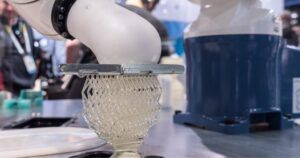The 3D printing revolution has undeniably reshaped the course of history, introducing a seamless way to bring computer-generated models to life. Over the years, various 3D printing techniques have emerged, and among them stands Stereolithography, a groundbreaking method that has left a significant mark on the industry. So, what exactly is Stereolithography, and why is it gaining such prominence? What advantages does it offer, and how does the Stereolithography process unfold?
Stereolithography Unveiled
Stereolithography (SLA), also known as tank photopolymerization or resin 3D printing, is an additive manufacturing technology that utilizes a light source, such as a laser or projector, to cure liquid resin. During the curing process, the resin transforms into hardened plastic, shaping the final object.
Unlike traditional printers, resin printers operate layer by layer, gradually solidifying the material until the finished piece is obtained. However, their components differ significantly, including the light source, print bed, and resin tank.
SLA printers use thermosetting resins that react to light. Exposure to specific wavelengths, particularly ultraviolet light, causes short molecular chains to bond. This transforms monomers and oligomers into plastics, creating predetermined structures, whether rigid or flexible.
One key reason for the popularity of SLA printing is the remarkable resolution and precision it offers, providing intricate details, sharpness, and smooth finishes that are challenging to achieve with other 3D printing techniques.
The Stereolithography Process
Now that we’ve explored what Stereolithography involves, let’s delve into the intricacies of the printing process. The steps for 3D resin printing are as follows:
Design Phase
The initial step is the design phase, where a computer-aided design (CAD) program or a 3D scanner is used to create a virtual model. This model is then exported in a 3D printable format, such as OBJ or STL. Once the printable file is ready, the printer needs to be prepared for the print job.
Most SLA printers come equipped with computer-installed software allowing users to load files, adjust print parameters, make printing modifications, add supports, or split models into layers for printing. Once the setup is complete, data is sent from the computer to the printer, either wirelessly or via cable.
Printing Phase
After confirming the settings, the printing process begins. At this point, the printer starts building the desired object layer by layer.
Post-Processing Phase
Once the printing is complete, the pieces need to be thoroughly washed in isopropyl alcohol to remove any uncured resin. After cleaning and drying, post-curing takes place. During this process, the pieces are placed in a UV oven, where they rest for a specified time, gaining increased strength, stability, and their final rigidity. Once the pieces are clean, additional steps like machining, priming, painting, and assembly can be undertaken for the finishing touches.
Advantages of SLA Technology
Stereolithography has become a favorite in the industry for several reasons:
1. Homogeneity: SLA stands out for the homogeneity achieved during printing. As the resin doesn’t fully cure between layers, polymerizable groups form a strong bond, making the piece not only more robust but also uniform and waterproof once fully cured.
2. Precision and Reliability: With a heated resin tank and a controlled printing environment, SLA ensures consistent conditions for each print. Combined with lower printing temperatures, this prevents pieces from expanding or contracting.
3. Smooth Finishes and Increased Detail:** SLA prints are incredibly precise and clean, comparable only to injection molding. Finished pieces lack the typical lines and imperfections found in FDM and SLS prints, requiring minimal post-processing like machining, sanding, or polishing. Moreover, SLA retains more details from the computer model than other printing methods, making it one of the most advanced and precise techniques available.
There’s no doubt that Stereolithography is a 3D printing technique poised to continue making a significant impact in the industry in the coming years. At Idelt, we stay abreast of the latest advancements in molding and manufacturing, ensuring we adapt to changes to deliver high-quality products to our valued customers.







